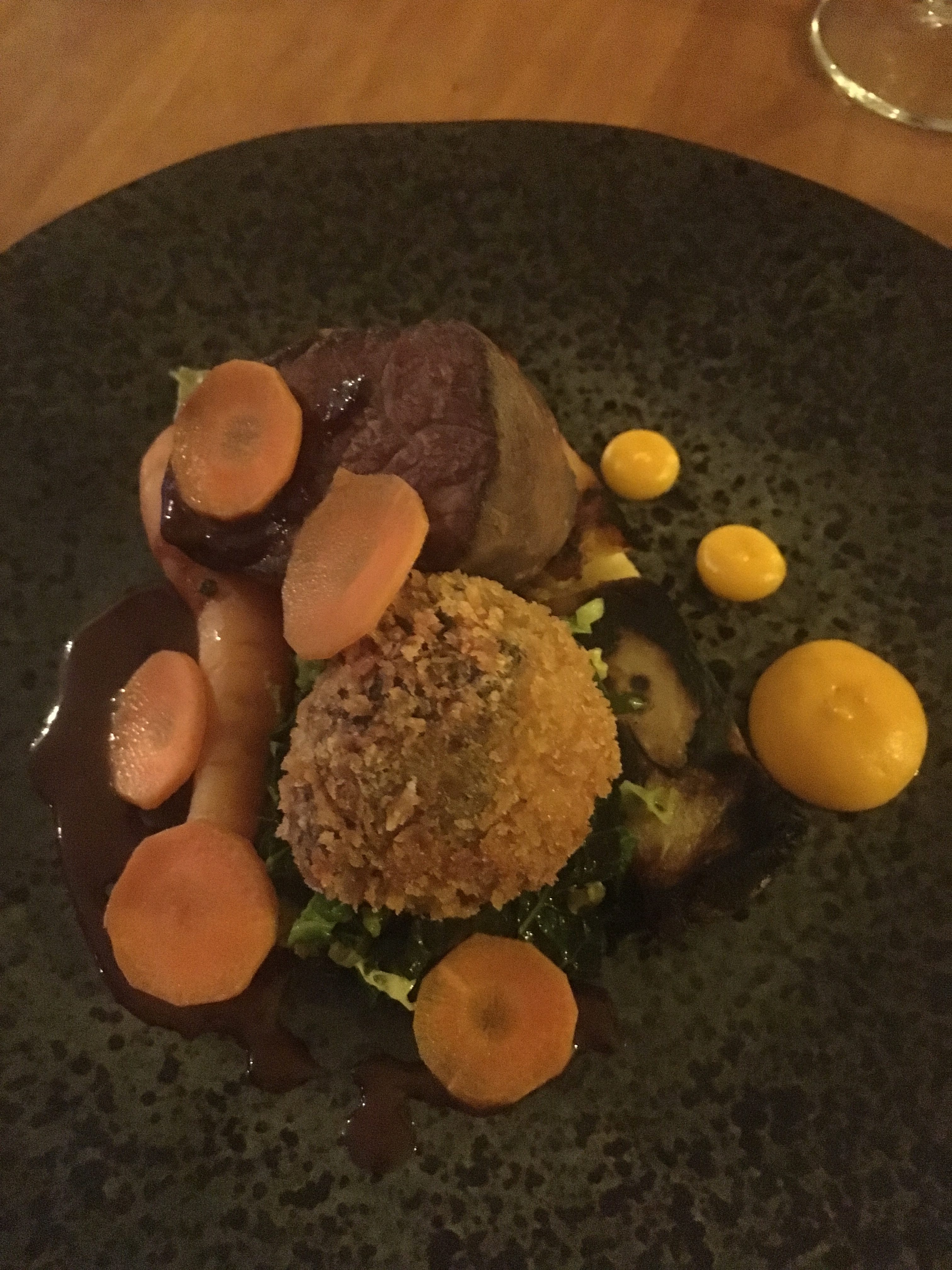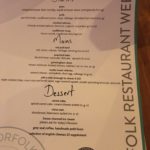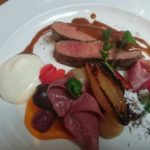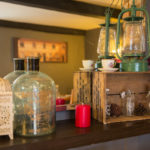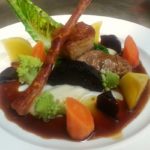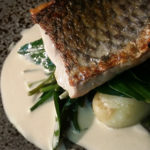Atmosphere: contrary to the view of most hospitality chains, you can’t paint it on by the yard; in fact, whatever you do you can’t guarantee it will ever materialise. This is because it’s only 50% what you do to the location to make it inviting. The other 50% is down to the buzz created by people who come to be entertained, and who they are and how they respond depends on how you entice them: there is more, but you’ll have to read the review before getting to that!
Here comes the paradox: at least one review I’ve read found the atmosphere of Market Bistro (strapline: “seasonal British food”) to be “cold” – though every aspect of the ambience on the Thursday night I visited struck me as warm, charming and seductively appealing. It was also pleasantly booked, such that I got a table for one without a booking but was soon surrounded by the low-level hum of alcohol-fuelled conversation.
The venue itself combines period features (a brick fireplace and beams), quirky low-level lighting that stopped short of dazzling, random bric-a-brac worthy of the late lamented Les Trois Garçons and vaguely modernist pictures alongside its stripped floors, comfortable seats and square wooden tables. MB’s service is routinely attentive (but not too attentive) and friendly too, as you would expect of a place they proudly advertise to be the Sunday Times favourite family-run restaurant. What’s not to like?
Granted that atmosphere is a very personal thing and may not appeal to all tastes, but then objectivity is not what restaurants are about. But if the ambience appeals then diners are more likely to relax, feel comfortable, enjoy their meal and recommend the place to their friends, so goes the marketing hyperbole.
I don’t recommend restaurants but I do review what I find, so it gives me pleasure to say what I found with the Market Bistro was consistently good, and for the same price (this being the premise of Norfolk Restaurant Week) decidedly better than the nearby Marriott’s Warehouse. The talent and refinement are there, but so is the vital attention to detail.
For example, a delightful amuse bouche of a miniature beetroot meringue with a cream cheese filling certainly justified MB’s fine dining ambitions, as did some excellent sourdough bread with whipped butter: every detail was spot on throughout. Witness my starter, which could have been a collection of flavours fighting each other but in practice combined blissfully: slices of poached pear, cubes of Blue Monday cheese (a great salt-sweet combination), puréed pear, a nutty granola crumb and sauce apparently made from Aspall’s cyder, topped with what might well have been a Parmesan crisp at a jaunty angle.
A word too for a well-judged wine list, deficient only for lack of 250ml glasses and half bottles. The 175ml of Malbec ordered proved rich, meaty, chocolatey and a perfect foil to the main course.
This comprised red poll beef (the native breed of East Anglia, hung on the farm for a minimum of 3 weeks) in two guises, as per the current vogue, on an attractive black plate with subdued patterns – possibly not as effective as a white plate to showcase a pretty dish. A thick and rare roundel of sirloin over some crispy cabbage was accompanied by a rissole of tail meat, a mini celeriac dauphinois and heritage carrots in various forms, plus a small puddle of jus.
Combining expensive cuts with cheaper but tastier slow-cooked meats works a treat, and in this case the oxtail proved itself the highlight of a great dish, by virtue of deep and moist beefy flavour in a crispy case, certainly better than being relegated to canned soup. It’s no accident that the dish as composed lacked every component you may wish for, so I purchased a £4 plate of crushed potatoes with crispy pickled capers.
How wonderful to see local ingredients used wisely and creatively. By this time I was on a roll and had to go for the dessert. Turning down the cheese, I plumped for a sliver of citrus tart with a kalamansi sorbet and raspberry shortbread crumb. “Kalamansi?” I hear you ask. Not native to East Anglia, to be sure. From Wikipedia:
Calamondin (× Citrofortunella macrocarpa or × Citrofortunella mites) is an important citrofortunella, meaning that it is an intergenetic hybrid between a member of the genus citrus (in this case probably the mandarin orange) and the kumquat belonging to Fortunella. Calamondin is called by many names, including: calamonding, calamondin orange, calamansi, calamandarin, golden lime, kalamunding, kalamansi, Philippine lime, “හින්නාරං”, Panama orange, Chinese orange, musk orange and acid orange
I can confirm the sorbet had an intensely citrus flavour with more than a hint of mandarin to it, while the tart was delicious with a perfect shortcrust pastry – nice though it would have been to see such a tart made from local seasonal fruits (plums, berries?)
The dessert was washed down by the MB’s recommended dessert wine: Les Pins, Monbazillac, Chateau Tirecul, la Graviere, described thus on the menu:
Sweet on the nose there is the richness of yellow peach and candied orange peel with lots of excitement coming from the hint of botrytis
OK, so no fungus in evidence but it was a well-chosen wine with fine balance and just a hint of spice. The sommelier, if there is one, is clearly a person worth knowing.
Tell the truth, even though I was on my own I had a perfectly splendid evening at the Market Bistro and was well impressed with the skill and verve with which the establishment is run. The relaxed ambience is conveyed by a professional team who know what they are doing, which is why the customers looked happy and the place hummed. Now that’s what I call an atmosphere, just as the knack of looking cool is appearing not to have to try too hard. It takes immense skill, practice and hard work, but done well it looks so easy.
Bravo: Market Bistro charges into my best 10 meals of 2016 and gets a Millward **** rating.

